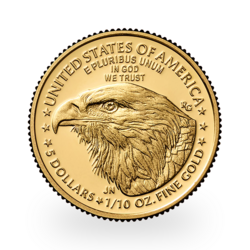One of the main arguments used by your banker to dissuade you from buying gold is that “it’s not generating anything”, either interest or dividends. It has been true, in a way, for some time. But, now that interest rates are at their lowest and that savings accounts and life insurance policies practically yield close to zero, you could use the same argument against his products. But I don’t think your banker will reply by telling you to keep your money because his products are worthless...
This argument is, of course, erroneous. One has to compare comparables. A bank note does not yield any interest either; you have to give it to the bank and invest it in a savings account, a life insurance policy, or a stock portfolio. Similarly, if you were to loan your gold to a business (in need of liquidity, or that has to pay someone with gold, or for other cases), said business would pay you some interest, it goes without saying.
But immediately comes to mind the question of risk: “If this business goes bankrupt, I’m going to lose my gold.” So we understand that the interest (or dividend) acts as counterparty to that risk. When you put your money in the bank, into several financial products, from the simple savings account to elaborate investment vehicles, you are taking the risk of losing a part or all of your capital. For a long time – in fact, since the 1929 depression – this possibility has been out of the picture, but it made a strong comeback since the 2008 crisis. That crisis was triggered by the bankruptcy of one bank (Lehman Brothers), and several others either failed or were saved in extremis, from Northern Rock to the Banco Espirito Santo. Even sovereign States can go bankrupt and ruin the depositors, as we’ve seen in Cyprus, or again be bailed out in extremis without solving the problem of a debt that is too heavy, as we’re seeing in Greece.
Hence, for those who would like to avoid investments yielding low interest and that could bring their invested capital to close to zero if the State goes bankrupt, there is the stock market. Stocks are doing great, of course, but we must be aware of the risks. On the Dow Jones, we are now at the third peak in the last two decades, and the first two (the internet bubble in 2000 and the sub-primes crisis in 2008) were followed by precipitous falls... Yield and risk are inseparable, and thus they must be addressed smartly, with lucidity. And, currently, the low yield on most financial vehicles does not compensate enough for the high and generalised risks globally– stock market bubbles, over-indebted States, failing banks. Systemic risk is very well present.
As a matter of fact, it is for this reason that central banks are doing all they can to maintain interest rates at the lowest possible. Depositors lose, but the over-indebted States are quite intent on not seeing the servicing of their debt exploding and the banks do not want to have to refinance themselves at higher rates, which would expose a lot of them to some serious problems... and, at the end, they’re the ones who make the decisions.
And this is where gold comes into play. It’s always good to own gold at all times, but especially when systemic risk is high, because gold cannot go bankrupt, it won’t go under. As far as safe preservation of capital for the long term, we can rest assured. As far as the yield... although gold does not pay interest, it has a price, a spot price that can go up a lot when assets and currencies are devalued or in crisis. So, finally, yes, gold can “yield” something and, at the very least, it protects your wealth. What could be better? Ask your banker!
Reproduction, in whole or in part, is authorized as long as it includes all the text hyperlinks and a link back to the original source.
The information contained in this article is for information purposes only and does not constitute investment advice or a recommendation to buy or sell.

















